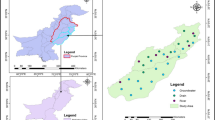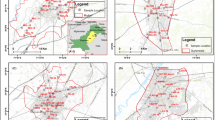Abstract
The objective of this study is to analyze the geochemical conditions associated with the presence of arsenic (As) and fluoride (F) in the phreatic aquifer of Coronel Moldes, in the central sector of the Argentine Chacopampean plain. The studied aquifer is composed of silty sand sediments of aeolian origin, typically loess-like sediments. The geochemical composition of water varies from sodium bicarbonate to sodium sulfate-chloride water. As contents range from low concentrations, below detection level, to 250 μg/l. High values of F (up to 12 mg/l) were recorded. A high As–F correlation was found (R 2 = 0.84). The pH varied from 7.31 to 8.85 and the nitrates reached concentrations up to 200 mg/l, indicating an oxidant environment. The highest values of As and F agreed with sodium bicarbonate waters as well as with the highest values of pH recorded. There was a high correlation between As and F− as well as between As and the Na/Ca ratio. The composition and texture of loess, low permeability and hydraulic gradients together with the geochemical features of sodium bicarbonate waters are proper conditions for the mobilization of As and F in groundwater in the central area of Argentina.










Similar content being viewed by others
References
APHA, AWWA, WPCF (1995) Standard methods for the examination of water and wastewater, 17th edn. Washington
Besuschio SC, Desanzo AC, Perez A, Croci M (1980) Epidemiological associations between arsenic and cancer in Argentina. Biol Trace Elem Res 2:41–55
Blanco MC, Paoloni JD, Morrás H, Florentino D, Sequeiro M (1999) Variabilidad espacial del paisaje pampeano sudoccidental y su influencia en la distribución del ion arsénico en suelos y aguas. I Congreso Argentino de Cuaternario y Geomorfología, La Pampa, Argentina. Actas, pp 25–26
Biagini R, Rivero M, Salvador M, Córdoba S (1978) Hidroarsenisismo crónico y cáncer de pulmón. Arch Argent Dermatol 48:151–158
Blarasin M (1984) Hidrología subterránea de la zona de Laguna Oscura. Córdoba, Argentina. Trabajo final de Licenciatura. U.N.R.C. 50 páginas
Blarasin M (2003) Geohidrología ambiental del Sur de Córdoba, con énfasis en la ciudad de Río Cuarto y su entorno rural. Ph.D. thesis, UNRC. 300 páginas
Blarasin M, Cabrera A, Matteoda E, Gomez ML (2004) Estudio hidrogeológico para el diagnóstico y propuesta de solución del problema ocasionado por el ascenso del nivel freático en la ciudad de Coronel Moldes, Córdoba, Informe técnico. Municipio de Coronel Moldes, 20 páginas
Buchet J, Lauwerys R, Roels H (1981) Comparison of urinary excretion of arsenic metabolites after a single oral dose of sodium arsenite, monomethylarsonate, or dimethylarsinate in man. Int Arch Occup Environ Health 48(1):71–79
Bundschuh J, Bonorino G, Viero AP, Albouy R, Fuertes A (2000) Arsenic and other trace elements in sedimentary aquifers in the Chaco-Pampean Plain, Argentina: 31st International Geol. Cong., Río de Janeiro, Brazil, 2000, pp 27–32
Cabrera A, Blarasin M (2001) Geoquímica de Flúor y Arsénico en el agua subterránea del Sur de Córdoba, Argentina. En Las Caras del agua subterránea. Edit. Instituto Geológico Minero de España, Barcelona ISBN 84-7840-427-9-1
Cantú M, Degiovanni S (1987) Génesis de los sistemas lagunares del Centro Sur de la Prov. de Córdoba. X Congreso Geológico Argentino. San Miguel de Tucumán II, 120–129
Carrica JC, Albouy ER (1999) Variaciones hidroquímicas en el agua subterránea de localidades del Partido de Puán, Provincia de Buenos Aires (Groundwater hydrochemical changes in towns of Puán District, Buenos Aires province). Hidrología Subterránea. II Congreso Argentino de Hidrogeología. Santa Fe, Argentina. Ser Correl Geol 13:221–230
Carrica JC, Bonorino G, Delpino D (2002) Fluoruros en el agua de manantiales en la zona de Zapala, provincia del Neuquén. Argentina. XXXII AIH and VI ALHSUD CONGRESS, Agua Subterránea y Desarrollo Humano, Mar del Plata, Argentina
CAA (Código Alimentario Argentino) (1994) Resolución 494/94. Boletín Oficial No. 27.932, 1ra sección. Art. 982 modificado
Custodio E, Llamas MR (1983) Hidrogeología subterránea. Seg. Edición (ed) Omega, S. A. Barcelona
Chebli G, Mozetic M, Rossello C, Bühler M (1999) Cuencas Sedimentarias de la Llanura Chacopampeana. Instituto de Geología y Recursos Minerales. Geología Argentina. Anuales 29(20):627–644
Chebotarev II (1955) Metamorphism of Natural Waters in the Crust of Weathering. Geochim Cosmochim Acta 8(22–48):137
Fernández Turiel JL, Galindo G, Parada MA, Gimeno D, García-Valles M, Saavedra J (2005) Estado actual del conocimiento sobre el arsénico en el agua de Argentina y Chile: origen, movilidad y tratamiento. Workshop Arsénico en aguas: origen, movilidad y tratamiento, Río Cuarto, Argentina. Actas, pp 1–22
Garrels RM, Christ CL (1965) Solutions, minerals and equilibrio. Harper & Row, New York, 450 pp
Hossain MA, Jungi A Sakugawa H (2004) Mobilization of arsenic from subsurfase by effect of bicarbonates ions in groundwater. Chemosphere 54(6):753–762
Kim K, Young Jeong G (2005) Factors influencing natural occurrence of fluoride-rich groundwaters: a case study in the southeastern part of the Korean Peninsula. Chemosfere 58(10):1399–1408
Marshall W, Warakomski M (1980) Amorphous silica solubility. II: Effect of aqueous salt solutions at 25°C. Geochim Cosmochim Acta 44:915–924
Martínez DE, Bocanegra E (2002) Hydrogeochemistry and cationic exchange processes in the coastal aquifer of Mar del Plata, Argentina. Hydrogeol J 10(3):393–408
Martínez DE, Osterrieth M (1999) Geoquímica de la Sílice Disuelta en el Acuifero Pampeano en la Vertiente Sudoriental de Tandilia. II Congreso Argentino de Hidrogeología, San Miguel de Tucumán, Argentina Ser Correlac Geol 13:241–250. ISSN 1514-4186
Nicolli H, Suriano JM, Gómez Peral MA, Ferpozzi LH, Baleani O (1989) Groundwater contamination with Arsenic and other trace elements in an area of the La Pampa province of Córdoba, Argentina. Environ Geol Water Sci 14(1):3–16
Nicolli HB, Tineo A, Falcon CM, García JW, Merino MH, Etchichury MC, Alonso M S, Tófalo O (2004) Aguas subterráneas con alto contenido en arsénico en el área de Los Pereyra, Tucumán, Argentina. XXXIII Congress IAH & 7° Congress ALHSUD. Zacatecas México. ISBN: 970-32-1749-4
Parkhurst DL, Appelo CAJ (1999) User´s guide to PHREEQC (Version 2): a computer program for speciation, batch reaction, one-dimensional transport, and inverse geochemical calculations. U.S.G.S. Water-Resources Investigations Report 99-4259, pp 1–312
Plummer LN, Prestemon EC, Parkhurst D (1991) An Interactive Code (NETPATH) for Modelling NET Geochemical Reactions Along a Flow PATH. U.S.G.S. Water Resources Investigations, 4078, 227 pp
Saxena VK, Sanjeev Kumar, Singh V (2004) Occurrence, behaviour and speciation of arsenic in groundwater. Curr Sci 86(2):281–284
Smedley PL, Kinniburgh D (2002) A review of the source, behaviour and distribution of arsenic in natural waters. Appl Geochem 17:517–568
Smedley PL, Nicolli HB, Macdonald DMJ, Barros AJ, Tullio O (2002) Hydrogeochemistry of arsenic and other inorganic constituents in groundwaters from La Pampa, Argentina. Appl Geochem 17(3):259–284
Sracek O, Bhattacaharya P, Jacks G, Gustafsoon JP, von Brömssen M (2004) Behavior of arsenic and geochemical modeling of arsenic enrichment in aqueous environments. Appl Geochem 19(2):169–180
Teruggi M (1957) The nature and origin of the Argentine loess. J Sediment Petrol 27(3):322–332
Truesdell AH, Jones B (1974) WATEQ, a computer program for calculating equilibria in natural waters. USGS J Res 2(2):233–248
Turner B, Binnig P, Stipp L (2005) Fluoride removal by calcite: evidence for fluorite precipitation and surface adsorption. Environ Sci Technol 39(9):9561–9568
Valenzuela VL, Ramírez HJ (2004) Análisis del comportamiento del Flúor en el acuífero que abastece a Hermosillo, Sonora, México. XXXIII Congress IAH & 7° Congress ALHSUD. Zacatecas México. ISBN: 970-32-1749-4
Villalba G (1999) Estudio geohidrológico con énfasis en la geoquímica del Flúor de la cuenca del Río Talita, Dpto. Río Cuarto, Córdoba. Trabajo final de Licenciatura. URC. Inédito 200 pág
WHO (World Health Organization) (1993) Guidelines for drinking-water quality. 2nd edn, vol 1. 188 p
Zack A (1980) Geochemistry of fluoride in the Black Creek aquifer system of Horry and Georgetown counties, South Carolina and its Physiological implications. Washington, D.C.; Geological Survey water-supply Paper 2067
Author information
Authors and Affiliations
Corresponding author
Rights and permissions
About this article
Cite this article
Gomez, M.L., Blarasin, M.T. & Martínez, D.E. Arsenic and fluoride in a loess aquifer in the central area of Argentina. Environ Geol 57, 143–155 (2009). https://doi.org/10.1007/s00254-008-1290-4
Received:
Accepted:
Published:
Issue Date:
DOI: https://doi.org/10.1007/s00254-008-1290-4




